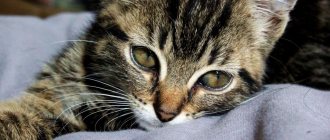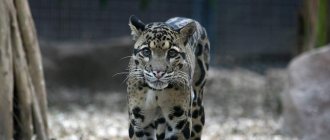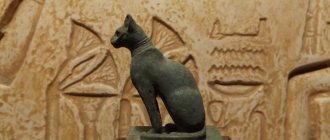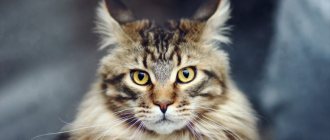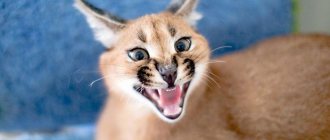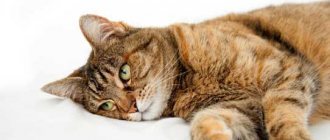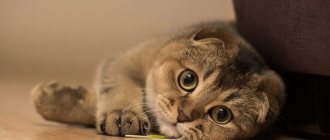The Serengeti is a cat breed bred in America based on the Bengal and Oriental Shorthair. Thanks to their ancestors, these animals are similar to wild bush cats from Africa, but their similarity is limited only by appearance. The breed is not widespread because it was created quite recently. The price of a cat reaches $2,000, but despite its high cost, it is becoming increasingly popular.
Serengeti cat breed
History of appearance
The Serengeti breed originated in the USA.
Breeder Karen Sauzman decided to breed a domestic cat with the appearance of a wild beast, a serval. Such attempts have already been made before. For example, savannah. It is a cross between an African bush cat and a domestic cat. But there are difficulties in breeding this breed. Males from the 1st to 3rd generation are born sterile, and subsequent descendants of servals gradually lose their resemblance to the African beast. Sauzman decided to change her approach to crossbreeding. She wanted to get a new breed without the blood of a wild animal. Bengals were crossed with spotted Orientals. This choice was not accidental - Bengal cats passed on to their descendants a large body size and bright color, and oriental beauties shared an elegant appearance, long limbs and large ears, and the spotted print on the coat also did not turn out to be superfluous. Later, the Serengeti cats received the blood of Maine Coons and Abyssinians.
Serengeti looks like a wild cat
The result was presented in 1994. A new breed of cat has appeared with the striking appearance of a wild African cat. The breeder gave her a euphonious name - Serengeti. This is the name of a protected area in Tanzania, where a large population of servals lives. The Serengeti cat breed was registered as an experimental felinological organization TICA, but its representatives do not yet have the right to take part in exhibitions and championships.
What's prohibited
Has official status in TICA (International Cat Association).
But due to the fact that at the moment the conditions (at least 50 nurseries) under which the breed is allowed for exhibitions are not met, they are not exhibited.
Appearance
If we take the external description of the Serengeti, they are very similar to the serval. They have a muscular body, long legs and neck, and large ears. Silky wool most often has a spotted color.
Serengeti cat color
The coat of Serengeti cats has a honey, smoky or gray background color with beautiful spots of chocolate or black. The breed standard identifies the main colors, which are called:
- black spotted tabby (contrasting spots);
- black ghost spot;
- smoky or gray ghost spotting.
The spots should be horizontal, round and slightly elongated; the presence of a dark path from the inner corners of the eyes is welcome.
The coat color of the new breed is truly exotic
Dimensions and anatomical features
The average weight of cats is from 8 to 10 kg, cats can reach 15 kg. Height is about 60 cm.
The head of the Serengeti is elongated, it expands evenly from the nose to the base of the ears. Cheekbones and cheeks are practically not prominent; the profile is a straight line from the nose to the eyebrows. The chin is clearly defined, the nose is moderately wide, often with a black edging. The neck is long, rather thick, expanding from the head to the body.
The ears of this breed are very large, almost as long as the muzzle, set vertically, set high on the back of the head close to each other. They are wide and deep at the base, the tips are rounded.
The Serengeti has large round eyes, the distance between them is slightly larger than the size of one eye. The preferred color is golden or yellow, light green or hazel is acceptable.
The photo shows that the Serengeti cat is a large animal
Serengeti cats have a strong, long body, a straight line of the back and hips, and shoulders that are approximately the same width as them. The legs are very high, strong and muscular, with medium-sized oval-shaped paws. The tail can vary in length from medium to short, but the preferred size is up to the animal's shoulder. The shape of the tail is wide at the base, tapering towards the end, the tip is always black.
Colors
According to the standard, the spots of this breed are round and oval in shape and located horizontally.
There are several standard colors of the Serengeti breed:
- Black tabby (spotted). The color of the spots is bright, contrasting with the main color.
- Black. In these cases, the color of the animal is darker, the markings are bright, but do not stand out strongly against the main color of the coat.
- Gray-smoky. The coat color is gray, the spots are black.
Character
Serengeti cats are very talkative cats. The talkativeness of this breed is their specific feature. They can follow their owner and purr, mumble, click and coo. Sometimes this, of course, is tiring, but you will not be able to convince the cat to remain silent.
The Serengeti cat is quite stubborn. If she wants something, then there is no point in hiding it in the farthest room. Because the Serengeti will overcome all obstacles, and the treasured thing will end up in its muscular paws. To divert your cat's attention from valuable interior items, provide her with a sufficient number of toys.
Serengeti are talkative, stubborn and very brave
Fearlessness is another trait of the Serengeti cat. They, as descendants of wild animals, are not afraid of any street dogs. The cat has a fighting character, so do not let the animal walk alone on the street - suddenly it will encounter an opponent that is too tough for it, or rather, too strong for it.
The Serengeti has strong leadership qualities. In the Serengeti house there is a leader. And if the owner accepts such leadership of the breed, then he is rewarded with its tenderness and kindness.
Maintenance and care
There are no special nuances in terms of caring for the Serengeti. It does not leave much fur on the floor, and to collect the falling out undercoat, it is enough to comb the cat every day with a special massage mitt or brush.
Cats of this breed are very clean; they independently remove dirt from their eyes and ears. The main thing is to regularly examine your pet for parasites or unusual changes (for example, redness).
Serengeti are clean and do not leave much fur.
To solve the issue of claw care, just buy a scratching post and place it in a visible place. Also, if possible, it is worth equipping the animal with slides, swings, and a cat tree. Otherwise, the cat will find an opportunity to play by jumping from cabinets onto curtains, tables and other things. She loves secluded places where she can rest quietly, and therefore it is often difficult to find her in the house - the Serengeti is so reliably hidden.
Nutrition
If you make a choice in favor of industrial feed, then representatives of the Serengeti breed should be fed ready-made dry mixtures of the super-premium or holistic class. They are well saturated and contain various vitamins, minerals and amino acids. Since these are large animals, they need to receive approximately one and a half times more calories than representatives of other breeds.
An adult cat should be fed 2 times a day at the same time, and kittens, depending on age, from 3 to 5 times a day.
Serengeti cats require more food than regular cats
Among the owners of purebred cats, there are those who prefer to prepare their diet from natural products. In this case, 70–80% of the total food volume should be meat and offal. Choose low-fat varieties - poultry fillet, beef tenderloin, veal, rabbit. Heart and stomachs can be given 2 times a week.
The remaining 20% of the diet is supplements, such as cereals, vegetables, eggs, and dairy products. You can treat your pet to a piece of cheese, shrimp, fish, and liver once a week. It is forbidden to feed cats fried, spicy, salty foods, sweets, bones, mushrooms, beans, and bread. Don't give bones or whole milk.
Health and life expectancy
Serengeti cats are predisposed to developing urolithiasis. In order not to miss the onset of the disease, you should remember that kidney disease in cats is much less common than in cats. It is also almost impossible to discern the first symptoms. The malaise appears immediately and suddenly.
Suddenly, a Serengeti cat cannot go to the litter box for a long time, begins to lick the opening of the urethra and meow pitifully, unexpectedly urinates in the wrong places, and so on. Self-medication is pointless; only a veterinarian can stop the problem. The veterinarian will also advise what to feed your pet to avoid such diseases.
Otherwise, the Serengeti is a cat of good health. The way the Serengeti looks completely determines its well-being. If she is active and cheerful, then everything is fine.
The breed has excellent health
The lifespan of a cat of this breed is about 10 years.
Breeding
Large cats mature a little later than other breeds. Thus, the first heat of a Serengeti female begins at 8 months, but individuals who have reached one and a half years of age are allowed to mate. Representatives of this breed can be crossed with each other, and mating with Bengals, Orientals and Abyssinians is also allowed. However, the Serengeti cannot be crossed with servals and wild cats. Kittens from such litters will not resemble this breed or will be infertile.
The date for the animals is arranged on the cat's territory. The animals get to know each other for about a day, and then begin mating games. Pregnancy lasts approximately 65–66 days. Kittens are born large - weighing 120–140 g. There are 3–5 cubs in one litter. Breeders hand over babies to new owners at the age of 3–4 months. Vaccination, training kittens to a tray and a scratching post falls on their shoulders.
Such cats grow up quite late
You cannot breed a cat more than once a year. Pregnancy and lactation greatly deplete the body. Full recovery takes on average 10 months.
Diseases
The Serengiti is a strong breed in itself and lives for 12-15 years, but a lot depends on the conditions in which you will keep it. They have a certain tendency to form stones and in general: their genitourinary system is their only weak point. Moreover, males, rather than females, begin to suffer from this disease earlier and more often. Symptoms: the animal often runs to the toilet, but it is clearly painful for him to urinate. It sits “on the potty” for a long time, drops or blood clots are noticeable in the urine. Reason: hypothermia, trauma, improper feeding (excess fish in the diet or lack of water). Don't put off visiting your doctor!
Deworming and vaccination should be carried out regularly, even if your cat only walks indoors. Parasites can easily enter his body through raw meat or water, and you can bring home pathogens of such dangerous diseases as rabies or panleukopenia on your own street shoes or hands.
Stroke the cat with unwashed hands and voila! — as soon as she licks her fur, the pathogens will begin their attack.
Castration and sterilization are a common condition of sale. The operation is carried out no earlier than 7-9 months, when the process of puberty has not yet come to an end, and the body can already endure such a serious procedure. In females, this is best done immediately after the first heat. During the operation, anesthesia and self-absorbing sutures are used.
If you want to castrate an adult animal, remember: your pet, most likely, even after the operation, will retain the habit of shouting in a bad bass voice at the appropriate time and pedantically marking corners. So it’s better not to put off your plans.
If you dream of getting offspring, wait until your cat reaches the age of 1 year: by this time she will have already gone through 2-3 heats and her hormonal levels will have stabilized. The same deadline is set for cats. A cat that gives birth more than 2 times in 3 years quickly gets tired, begins to get sick and dies early. During pregnancy, a cat gives birth to from 3 to 8 kittens. A partner should be chosen carefully, studying documents and pedigree, and preferably an experienced one. Professionals breed Serengiti cats with Oriental cats and Bengals.
Buying a Serengeti kitten
Kittens are given to a new family from 3 months. You can choose a Serengeti kitten based on the following criteria. They must have:
- large, straight and high-set ears with rounded tips
- the distance between the eyes is greater than the length of one eye, the eyes themselves are large, almost round, curious;
- drawing, if any, is only spotted tabby;
- Long neck;
- thin tail with a rounded tip;
- the coat should not fit very tightly to the body, there should be little undercoat;
- very long legs;
- absolutely straight back line;
- playfulness, fearlessness, curiosity and high mobility.
The photo shows a Serengeti kitten, ready for a new family.
Catteries where you can buy Serengeti kittens exist in Russia, Europe, America and Australia. There are no more than 1000 such cats in the world. Their price can vary from $500 to $3000.
Mr. Cat recommends: cost of a kitten
The breed is only gaining popularity, and it is all the easier to control the integrity of breeders, of whom there are not many.
The cost of the Serengeti averages 1000-2000 dollars. Cats sold second-hand and at a lower price are ordinary yard species or crosses with other breeds. Therefore, do not try to save money and ask the seller for documents.
Today, many advertisements and information about conscientious breeders have been published on the Internet, who will subsequently become the owner of a Serengeti who will become a real pet.
Photo gallery of cats of the Serengeti breed:
1111
